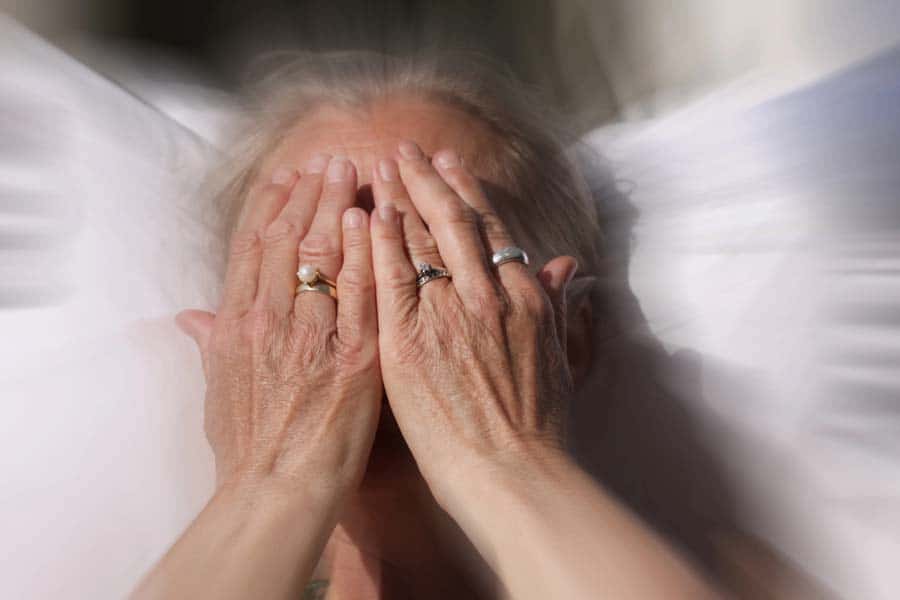Please view our updated COVID-19 guidelines and visiting procedures →.

Delirium is a medical condition characterized by inattentiveness (the inability to pay attention in a conversation or directly answer a question) and confusion (such as disorientation or repeatedly asking the same question) and is usually of recent onset (a delirious patient may have been oriented and lucid only days or even hours earlier, and have no history of cognitive impairment). People with delirium may be somnolent and difficult to wake one minute and agitated and hyperalert the next -- so-called ”mixed delirium,” continually somnolent – “hypoactive delirium” – or continually agitated and combative -- “hyperactive delirium.”
Delirium is very common in seriously ill, hospitalized patients – especially in the ICU – and is frequently seen in hospice patients both at home and in the inpatient setting. For those with hyperactive delirium, agitation, and even combativeness can be very distressing for family members and caregivers. Similarly, in a study of patients who recovered from delirium and could recall their experiences, 86% said they were distressed by them, with fear and visual hallucinations being the most common distressing themes.
The most common cause of delirium is an underlying medical condition (for example, an infection like pneumonia or abnormal blood chemistries), which, if successfully treated, causes the delirium to resolve. Delirium may also be caused by unmanaged pain, urinary retention (with an associated distended, painful bladder), long-standing constipation, shortness of breath, and other unpleasant symptoms.

While patients in hospice are typically not treated for their underlying illnesses, hospice providers are expert in relieving unmanaged symptoms, which often leads to a marked improvement in delirium. Because these symptoms can be difficult to diagnose in people who are unable to talk or suffering from cognitive impairment (such as dementia), hospice nurses may use “non-verbal cues” to physical distress such as grimacing, moaning, or agitation, to diagnose distress, and find that delirium calms when appropriate relief is provided. Medications may also cause delirium, which resolves when the medication is stopped. Some of these medications are used in hospice, including benzodiazepines such as lorazepam (Ativan ©) for anxiety, ondansetron for nausea (Zofran ©), SSRIs such as escitalopram for depression (Lexapro ©), corticosteroids for cancer and inflammation (Decadron ©, Prednisone ©) and others.

If unmanaged pain, constipation, urinary retention, or medications are not the cause of delirium in hospice patients, behavioral interventions can help, including assuring a calm, quiet environment, repositioning the patient to a more comfortable position in bed, having family and friends provide reassurance at the bedside, playing music, or providing recreational activities such as games or TV.

Antipsychotic medications may also be used for the management of delirium in hospice patients, including haloperidol (Haldol ©), risperidone (Risperdal ©), olanzapine (Zyprexa ©), quetiapine (Zyprexa ©), and others. When these medications are necessary, engagement of family members is critical to decision-making. Antipsychotics have a mixed record in relieving delirium but offer the advantage of potentially calming patients with hyperactive delirium without sedation. Families are educated that delirium may persist while a trial of antipsychotic agents is used in the hope of providing relief.
At CT Hospice, delirious patients have been successfully managed with haloperidol, olanzapine, and quetiapine, allowing them to meaningfully engage with families – though sometimes considerable confusion, inattention, and even some agitation persist – during their last days of life.
When antipsychotics don’t work, families are asked to consent to sedation as a last resort in settling an agitated patient. Some families, wanting to relieve agitation as quickly as possible, may elect to forgo antipsychotics and use sedation earlier.
In hyperactive delirium at the very end of life – “terminal agitation” – antipsychotics rarely offer the possibility of relieving agitation while also maintaining consciousness. Patients only hours from death, pale, sometimes tinged blue, with very low blood pressure, oxygen levels, and pulse, are usually deeply unconscious and show only brief signs of delirium. Often, this happens while they are being cleaned and repositioned, and is manifest by their opening their eyes wide and adopting a frightened expression. One means of managing this is to premedicate with an opioid such as morphine to ensure they are not having pain while being cleaned. Sedation with a barbiturate or benzodiazepine such as phenobarbital, lorazepam (Ativan ©), or diazepam (Valium ©) may also be appropriate.
Notably, delirium may be confused for anxiety, a psychiatric or emotional – rather than a medical condition. Typically, anxious people can say they are anxious, unlike people with delirium. For example, they may fear death, have spiritual concerns, worry about leaving loved ones behind, or have financial or other practical concerns. Delirious people, being inattentive and confused, usually speak in unintelligible, garbled or nonsensical terms – making anxiety unlikely. A future blog will explore anxiety more closely.

As a not-for-profit, we depend on generous donors to help us provide customized services and therapies that aren’t completely covered by Medicaid, Medicare, or private insurance.
Please make a gift to help us sustain the highest standard of care.
Admissions may be scheduled seven days a week.
Call our Centralized Intake Department: (203) 315-7540.